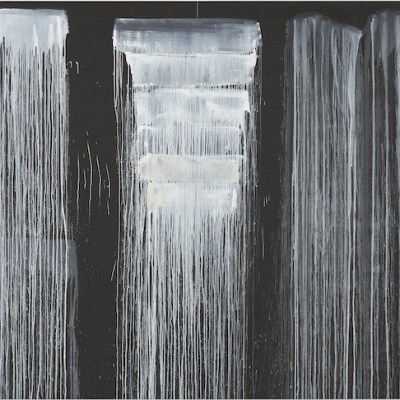Julie Mehretu has never shied away from making art on a monumental scale. In 2016–17, the Ethiopian-American artist relocated her studio to an abandoned church in Harlem to complete the enormous paintings that comprised her commission for the San Francisco Museum of Modern Art, HOWL, eon (I, II) (2017). An earlier piece, Mural (2010), dwarfs visitors to Goldman Sachs’ lobby in New York at 24 metres long and 7 metres high. By comparison, Mehretu’s new installation at Kettle’s Yard in Cambridge conveys an unexpected intimacy, through appearance – 84 small untitled sheets of paper arrayed in a grid – and through medium, the monotype.
The first impression made by the grid is one of systematic order – the wall text compares the work to an alphabet or periodic table – that erodes into individualised abstraction. Each sheet bears its own range of references, some echoing the improvisational marks of graffiti, while others resemble city maps, calligraphy, or human bodies. In contrast to the colourful work that defined her early career, Untitled (2018) uses only black printer ink on white paper with occasional acrylic. It is clear that Mehretu is invested in both the representational value of the artist’s mark and the perhaps misplaced human desire to make order out of abstraction.
Installation view of ‘Julie Mehretu Drawings and Monotypes’ at Kettle’s Yard, Cambridge, 2019. Photo: Stephen White. Courtesy the artist, Marian Goodman Gallery, and White Cube

Mehretu’s chosen medium for the work further highlights the tension between these ideas. The monotype is a relatively recent adoption for the artist, who first gained recognition for her paintings that overlaid architectural blueprints with a kaleidoscope of shapes and colours. (These early and more recent works will be collected in the first travelling mid-career survey of Mehretu’s work, opening at the Los Angeles County Museum of Art in November of this year.) Monotype prints are often favoured by artists because they are one-off productions that cannot be reproduced. Monotypes also bring an element of chance to the process of creation. After applying ink to a flat surface like copper plates or the acrylic panels used by Mehretu and pressing the ink on to paper, the artist must relinquish control over the appearance of the final print.
Mehretu uses these elements of the monotyping process to explore questions of permanence. On certain sheets, it appears that marks have been erased or purposefully smudged, an act of control that could be read as defying the spontaneous aspect of the monotype. Perhaps the erasures and Mehretu’s occasional acrylic marks, applied after the printing, suggest that chance and purpose must work together to produce a lasting image.
Installation view of two of the Drawings for Helen’s Room (2018) by Julie Mehretu at Kettle’s Yard House, Cambridge in 2019. Photo: Stephen White. Courtesy the artist, Marian Goodman Gallery, and White Cube

In addition to the 84 monotypes, presented in one of the galleries at Kettle’s Yard, Mehretu produced eight works for the house titled Drawings for Helen’s Room (2018). Helen is Helen Ede, art teacher and wife of Jim Ede; their home together from 1958–73, filled with their remarkable collection of modern art, comprises the heart of the museum. The drawings that Mehretu created for Helen’s room – the only one not open to the public when the Edes lived at Kettle’s Yard – are even smaller than the monotypes and more playful, the thin pen marks and heavy smudges comprising a feast of movement, like fireworks or birds taking flight. Texturally dense and blurred like faces in early photographs, these ink-on-paper works are a compelling distillation of the play with figuration and abstraction, intimacy and grandeur, that defines this new phase of Mehretu’s career.
‘Julie Mehretu Drawings and Monotypes’ is at Kettle’s Yard, Cambridge until 24 March.



